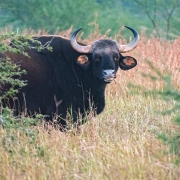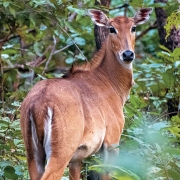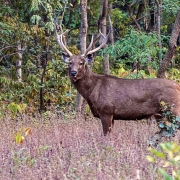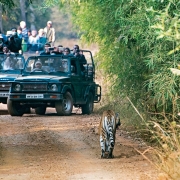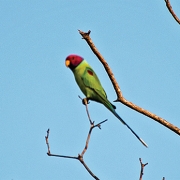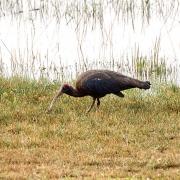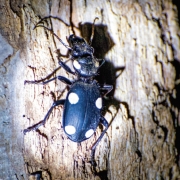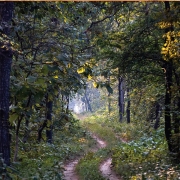
Etcetera
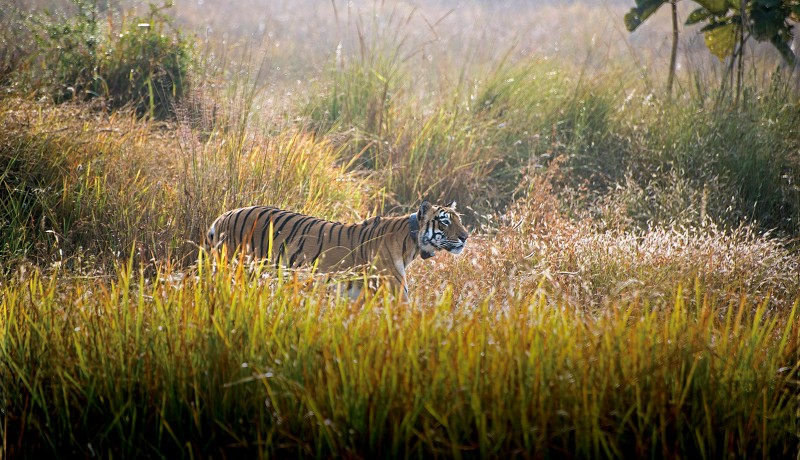
A Project Tiger reserve, Tadoba Andhari is one of the best places in the world to sight a tiger in the wild
We were caught in a nasty traffic snarl, surrounded by vehicles stacked bumper to bumper and in no hurry to go anywhere or willing to give an inch of space to anyone wanting to get through. Not that we wanted to go anywhere. We had arrived and were equally determined to hold our ground and not cede an inch to intruders with designs on encroaching on our patch of turf. A few vented their frustration in hushed voices but no one really cared, for we were all focused on one thing alone: the tiger.
Yes, tigress Choti Tara (T7 in forest department records) and her two sub-adult male cubs were the guilty ones and the cause of the traffic chaos on the narrow forest trail in the middle of Tadoba Andhari Tiger Reserve in northwest Maharashtra. The three cats strode like royalty across a golden meadow of sundried grass, indifferent to the ruckus they had created. Camera shutters tripped wildly as wildlife enthusiasts, sporting phallic lenses, and tourists with cell phones captured the striped felines, their fur coats rippling in the sun. There were around 25 to 30 vehicles stacked up along the trail that fringed the grassland and, as word spread about the ‘sighting,’ more raced in to add to the tight squeeze.
“You are very lucky to see the tiger on your first game drive,” the forest guide accompanying our vehicle congratulated us. On an average, visitors get to see a tiger once in every four game drives; that, our guide added, ranked Tadoba as one of the best places in the world to see a tiger in the wild. Now that we had seen the queen and two princes of the jungle, we were keen to meet the other residents of the forest.
Thankfully, Choti Tara decided to lead her family away from human intrusion, and we were able to navigate our way out of the thinning traffic jam. The prized tiger sighting behind us, Bhautik Desai, the naturalist from Svasara Jungle Lodge, decreed it was time to enjoy our packed safari breakfast. We drove through a meadow of golden grass that rippled in the gentle caress of the wind to a ledge overlooking a water hole. “You never know; a tiger might just stop by here to have a drink,” he said, as we munched on sandwiches and sipped our coffee.
Suspense—not knowing what surprises the forest might spring on you—is what makes a wildlife safari so compelling. Much as we would have liked to encounter a tiger again, we realised two tiger sightings on a single game drive was probably asking for too much. All the forest had to offer us was a lone ibis by the waterfront, the song of birds, pink and white wild-grass blooms nodding in the wind and spider webs draped like delicate lace on branches of trees. We packed the scraps of our meal, making sure we left no imprint of our presence behind, and drove on.
Then we encountered a gaur, also called the Indian bison, who had a serious issue with our presence in his domain. The strapping specimen with rippling muscles that body builders would have envied stepped out from the thicket on to the forest trail in front and stopped to give us a once over. Apparently, he did not like what he saw and made his displeasure known by grunting and threatening to charge us with his rapier-like horns. Okay, message registered. Our driver needed no prompting, and started to back up. Only when we had backed up far enough did the menacing beast cross over to the other side of the unpaved safari trail. “Most unusual,” the naturalist observed. “These animals are generally quite gentle.” Maybe so, but we thought he looked exceptionally handsome and striking in his angry avatar.
Other natives of the forest such as the sambar stag sporting an impressive set of antlers and his female companion with a fawn in tow, a mongoose, a troop of monkeys were by and large indifferent to our presence. A cursory glance to see we meant no harm, and they returned to their grazing and foraging.
Our base camp at Svasara Jungle Lodge was abuzz with excited chatter when we arrived. Almost every guest who had been out on a safari drive that morning had seen Choti Tara and her two cubs. This is because Tadoba operates on a different system from most other national parks that require vehicles to remain within the zone they have entered. At Tadoba, there are six entry gates but once a vehicle is in the park, it may roam anywhere it chooses. As a result, when there is a tiger sighting, as was the case on our morning game drive, everyone converges on the spot, creating a traffic jam.
Guests soon moved to their rooms but we hung on in the airy lounge with Ranjit Mandal, the general manager of the resort, a passionate wildlife enthusiast. He regaled us with stories of tiger encounters and sightings over the years since the inception of the resort in 2011. He filled us in about the lineage of the present stock of tigers in the park; of the different territories that dominant males controlled. He spoke of Maya, one of the most magnificent tigresses he had ever seen, and of how Maktasur, the usurper, had ousted Gabbar as the alpha male and laid claim to all the tigresses, Maya included, in his territory.
He then showed us a spider web crawling with little ones that had recently hatched. Yes, his love of the wild embraces all things, big and small. “All the trees you see here, except one, are less than seven years old,” he informed us as we walked around the property. It did not take rocket science or horticultural insight to figure that out. The simple fact is that this was barren land, except for that one tree, when they started to build the resort. Today the 10-acre property is a forest retreat studded with orange orchards, a butterfly garden, bamboo groves and 12 rooms (each with a private sit-out) in a single creeper-draped row. Eco-friendly is the underlying theme of the resort: solar panels, recycled water treatment plants and low-slung functional cottages that blend into the landscape.
That evening we set off again with Desai on a fascinating nature walk that turned out to be an insect safari of sorts. Crab spiders; grasshoppers camouflaged in the grass; beetles hiding in the crevasses of tree trunks…. The prized sighting was a spotted beetle; a black beauty with six large symmetrical white spots on its body. And then we saw a kill. Not a tiger kill but a wood spider wrapping its dinner—a fly trapped in its web—in a silky white cocoon.
We returned to our lodge, dusty and tired, and after a quick shower headed to the convivial space outside the Teak House (an open-sided, red-tiled roof dining area), where fragrant cups of tea downed with moist cake and pastries satiated incipient hunger pangs. Some guests relaxed at the pool-spa in the embrace of a forest, revelling in its signature therapy, which included abundant use of juicy Nagpur oranges. We lingered on with other guests around a bonfire, swapping tales of sightings as a new moon smiled at us from a star-laden sky.
Early next morning, we braved the chilly bite in the air as we set out on a game drive via Alijhanja gate. This part of the forest, rimmed by the Chimur Hills, is one of the most charming parts of the national park we were told. As we were not looking for tigers this time around, there was no sense of urgency—no scanning the ground for pug marks or listening for cheetal and sambar alarm calls that might indicate where the striped cat might be lurking. It was time to look up and admire the biodiversity around us: soaring teak trees, bonewhite Indian ghost trees, creaking bamboo groves and mahua trees on whose fermented fruit langurs and sloth bears get drunk. We learned to appreciate the ingenuity of creation in the tangled canopy around us: a marching column of flaming red fire ants; a long-tailed rufous tree pie; an oriental magpie robin… we stopped and cut the engine of our vehicle to listen to the song of the forest; the rustling of leaves blending in with a symphony of bird calls.
“How was the safari?” someone asked as we rolled into the resort. Before we could reply ‘amazing’, the guest who had shared our vehicle snapped: “Nothing. We saw nothing.” Were the two cheetal stags, horns locked in combat, nothing? Was the sambar with her fawn, their fur coats glinting in the rays of the morning sun, nothing? Sadly, our companion was wearing tiger blinkers, which blinded him to the abundant beauty that is Tadoba Andhari Tiger Reserve.
FACTFILE
GETTING THERE
Tadoba Andhari Tiger Reserve, one of the 29 Project Tiger reserves in India, is a two-hour drive from Nagpur, the closest airport and most convenient railway station.
ACCOMMODATION
There are a number of budget lodges and homestays. Svasara Jungle Lodge with its scenic location and superior standards is the best option. Website: www.svasararesorts.com; Tel: (0)9370008008
SAFARI
Safaris have to be booked in advance and online. Contact Maharashtra Tourism at www.maharashtratourism.gov.in
Text & photos: Gustasp and Jeroo Irani Featured in Harmony — Celebrate Age Magazine November 2018
you may also like to read
-
Cracking the longevity code
Small yet impactful choices can be game-changers, writes Srirekha Pillai At 102, there’s no stopping Chandigarh-based Man Kaur, the world’s….
-
Home, not alone
While a regulatory framework is vital for senior-care facilities, the need of the hour is to develop an ecosystem to….
-
Birthday Girl
Published in a special edition to honour Japanese master storyteller Haruki Murakami’s 70th birthday, Birthday Girl (Penguin; Rs 100; 42….
-
A huge treat for music lovers
Published as the revised and updated second edition, Incomparable Sachin Dev Burman (Blue Pencil; Rs. 599; 470 pages) the authoritative….



